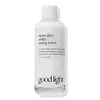What's inside
What's inside
 Key Ingredients
Key Ingredients

 Benefits
Benefits

 Concerns
Concerns

No concerns
 Ingredients Side-by-side
Ingredients Side-by-side

Water
Skin ConditioningGlycerin
HumectantLimnanthes Alba Seed Oil
Skin ConditioningCeramide NP
Skin ConditioningTremella Fuciformis Sporocarp Extract
AntioxidantNiacinamide
SmoothingSodium Hyaluronate
HumectantPanthenol
Skin ConditioningUrea
BufferingAllantoin
Skin ConditioningTocopherol
AntioxidantAvena Sativa Kernel Extract
AbrasivePelargonium Graveolens Flower Oil
MaskingRose Flower Oil
MaskingCitrus Aurantifolia Fruit Extract
Skin ConditioningHovenia Dulcis Fruit Extract
Skin ConditioningCitrus Limon Fruit Extract
MaskingCocos Nucifera Fruit Extract
EmollientOpuntia Ficus-Indica Fruit Extract
Skin ConditioningPyrus Malus Fruit Extract
Skin ConditioningPhenoxyethanol
PreservativePropanediol
SolventArgania Spinosa Kernel Oil
EmollientCanola Oil
EmollientHelianthus Annuus Seedcake
AbrasiveSodium Lactate
BufferingPolyglyceryl-10 Stearate
Skin ConditioningCarbomer
Emulsion StabilisingPentylene Glycol
Skin ConditioningXylitylglucoside
HumectantArginine
MaskingAnhydroxylitol
HumectantXylitol
HumectantCeramide AP
Skin Conditioning1,2-Hexanediol
Skin ConditioningMyrtus Communis Oil
MaskingFerula Galbaniflua Resin Oil
AntimicrobialThuja Occidentalis Leaf Extract
AntioxidantVanilla Planifolia Fruit Extract
Skin ConditioningRosa Canina Fruit Oil
EmollientCitrus Aurantium Bergamia Fruit Oil
MaskingOlea Europaea Fruit Oil
MaskingJasminum Officinale Oil
MaskingCitrus Grandis Peel Oil
MaskingPersea Gratissima Oil
Skin ConditioningCedrus Atlantica Bark Oil
MaskingLavandula Angustifolia Oil
MaskingEthylhexylglycerin
Skin ConditioningDisodium EDTA
Water, Glycerin, Limnanthes Alba Seed Oil, Ceramide NP, Tremella Fuciformis Sporocarp Extract, Niacinamide, Sodium Hyaluronate, Panthenol, Urea, Allantoin, Tocopherol, Avena Sativa Kernel Extract, Pelargonium Graveolens Flower Oil, Rose Flower Oil, Citrus Aurantifolia Fruit Extract, Hovenia Dulcis Fruit Extract, Citrus Limon Fruit Extract, Cocos Nucifera Fruit Extract, Opuntia Ficus-Indica Fruit Extract, Pyrus Malus Fruit Extract, Phenoxyethanol, Propanediol, Argania Spinosa Kernel Oil, Canola Oil, Helianthus Annuus Seedcake, Sodium Lactate, Polyglyceryl-10 Stearate, Carbomer, Pentylene Glycol, Xylitylglucoside, Arginine, Anhydroxylitol, Xylitol, Ceramide AP, 1,2-Hexanediol, Myrtus Communis Oil, Ferula Galbaniflua Resin Oil, Thuja Occidentalis Leaf Extract, Vanilla Planifolia Fruit Extract, Rosa Canina Fruit Oil, Citrus Aurantium Bergamia Fruit Oil, Olea Europaea Fruit Oil, Jasminum Officinale Oil, Citrus Grandis Peel Oil, Persea Gratissima Oil, Cedrus Atlantica Bark Oil, Lavandula Angustifolia Oil, Ethylhexylglycerin, Disodium EDTA
 Reviews
Reviews

Ingredients Explained
These ingredients are found in both products.
Ingredients higher up in an ingredient list are typically present in a larger amount.
1,2-Hexanediol is a synthetic liquid and another multi-functional powerhouse.
It is a:
- Humectant, drawing moisture into the skin
- Emollient, helping to soften skin
- Solvent, dispersing and stabilizing formulas
- Preservative booster, enhancing the antimicrobial activity of other preservatives
Allantoin is a soothing ingredient known for its protective and moisturizingg properties. Because of this, it is often added to products with strong active ingredients.
Studies show higher concentrations of this ingredient can promote wound healing.
Though it can be derived from the comfrey plant, allantoin is produced synthetically for cosmetic products to ensure purity.
Learn more about AllantoinArginine is an amino acid that is important for human development. Your body uses is it to produce hair keratin and skin collagen.
As a cosmetic ingredient, Arginine has antioxidant properties and can also help repair damaged skin. This ingredient is derived either synthetically or from animals.
Arginine isn't fungal acne safe when used in the presence of other lipids (fats, fatty acids, oils, esters, etc). Oils and fats occur naturally within the skin, so take caution when using Arginine if you're prone to fungal acne.
Learn more about ArginineCarbomer is a polymer of acrylic acid. Its main role is to create a gel consistency.
A high amount of carbomer can cause pilling or balling up of products. Don't worry, most products contain 1% or less of carbomer.
Panthenol is a common ingredient that helps hydrate and soothe the skin. It is found naturally in our skin and hair.
There are two forms of panthenol: D and L.
D-panthenol is also known as dexpanthenol. Most cosmetics use dexpanthenol or a mixture of D and L-panthenol.
Panthenol is famous due to its ability to go deeper into the skin's layers. Using this ingredient has numerous pros (and no cons):
Like hyaluronic acid, panthenol is a humectant. Humectants are able to bind and hold large amounts of water to keep skin hydrated.
This ingredient works well for wound healing. It works by increasing tissue in the wound and helps close open wounds.
Once oxidized, panthenol converts to pantothenic acid. Panthothenic acid is found in all living cells.
This ingredient is also referred to as pro-vitamin B5.
Learn more about PanthenolPhenoxyethanol is a preservative that has germicide, antimicrobial, and aromatic properties. Studies show that phenoxyethanol can prevent microbial growth. By itself, it has a scent that is similar to that of a rose.
It's often used in formulations along with Caprylyl Glycol to preserve the shelf life of products.
Sodium Hyaluronate is hyaluronic acid's salt form. It is commonly derived from the sodium salt of hyaluronic acid.
Like hyaluronic acid, it is great at holding water and acts as a humectant. This makes it a great skin hydrating ingredient.
Sodium Hyaluronate is naturally occurring in our bodies and is mostly found in eye fluid and joints.
These are some other common types of Hyaluronic Acid:
Learn more about Sodium Hyaluronate